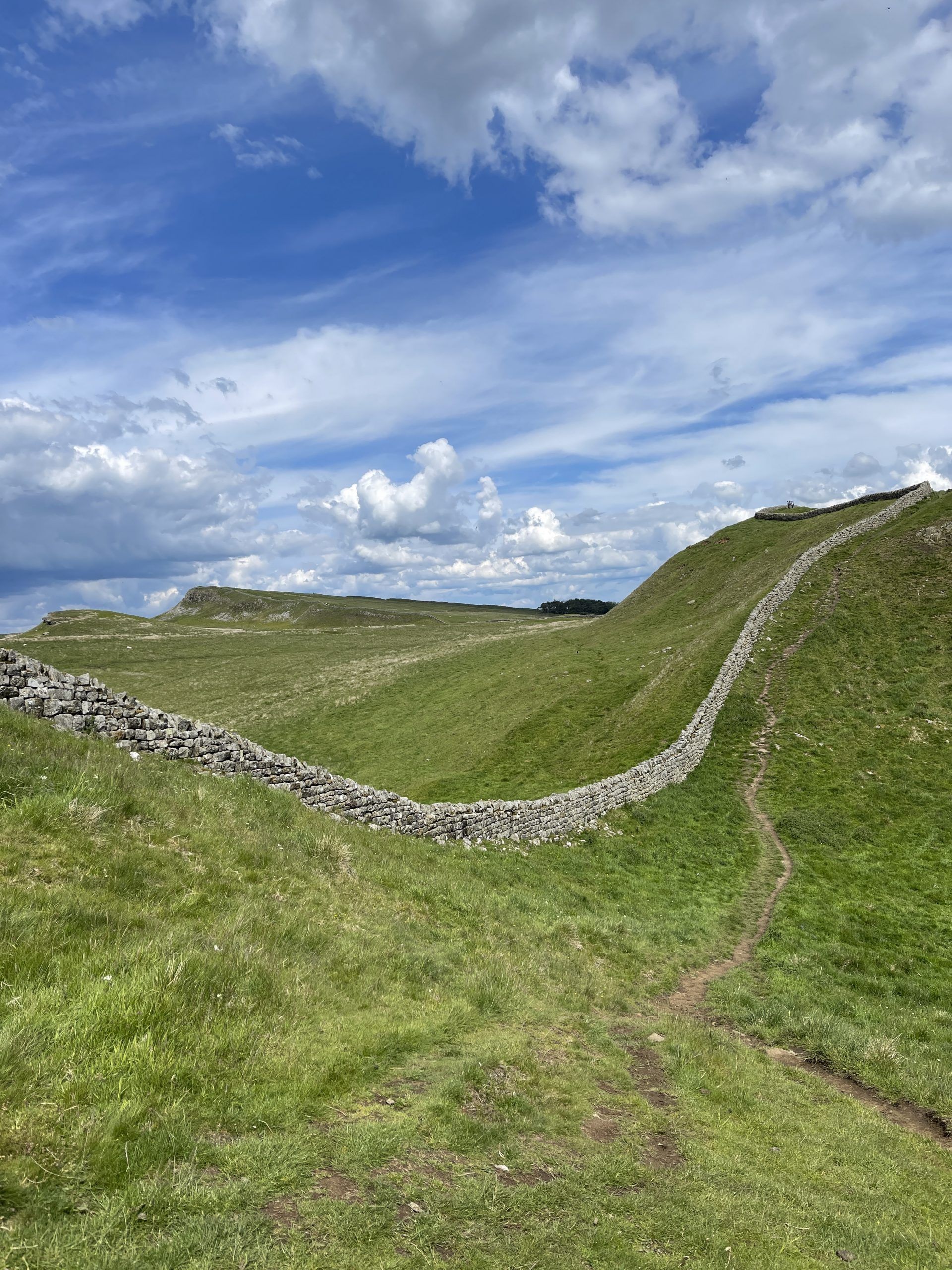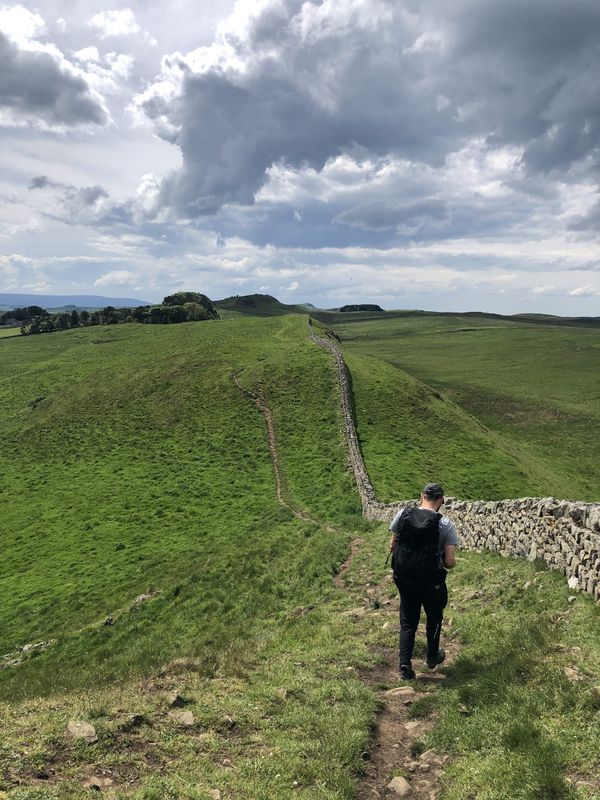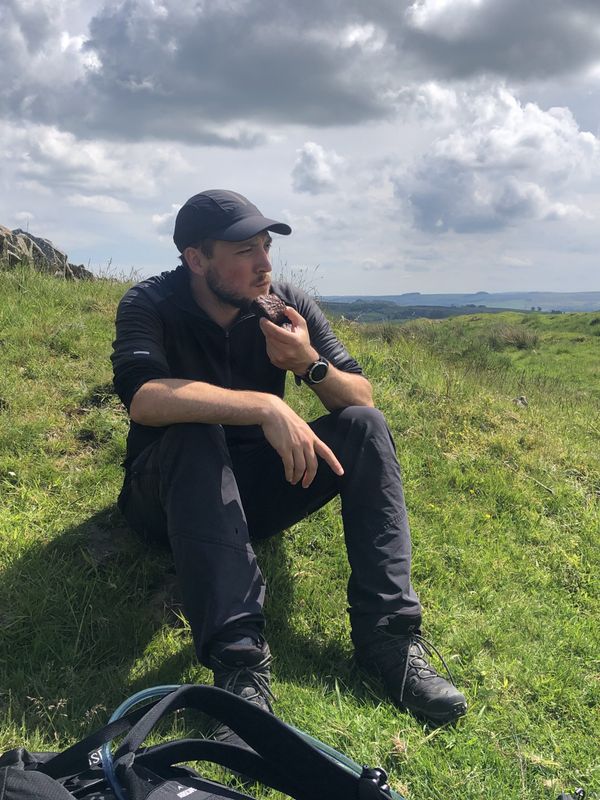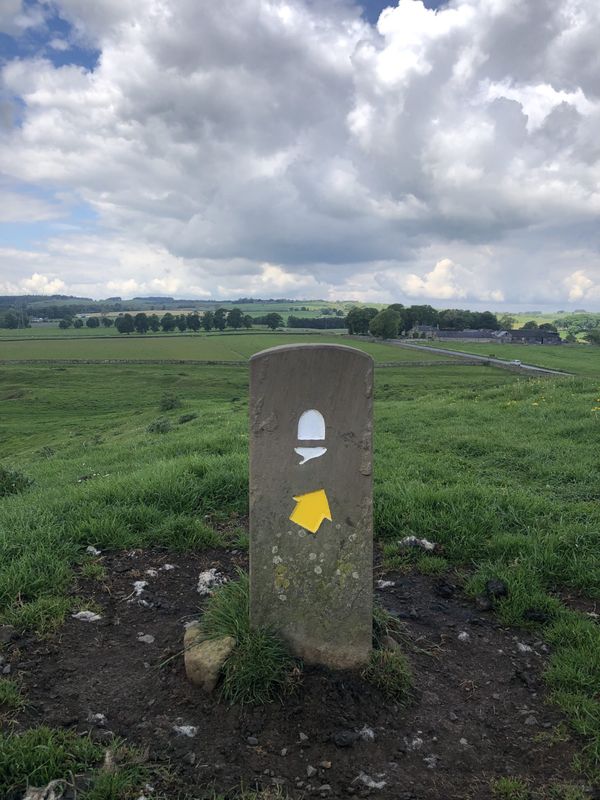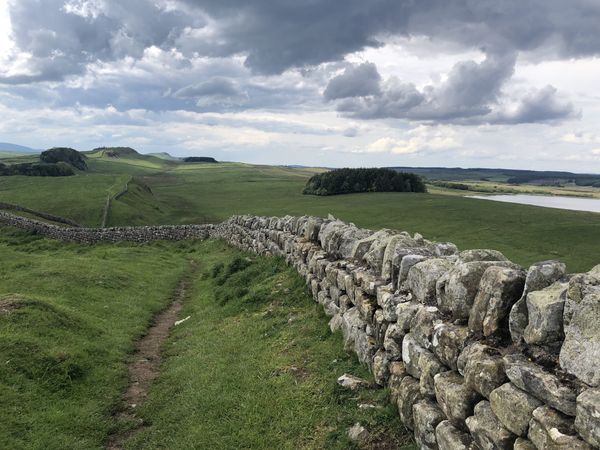At the end of May 2022, we spent a week hiking the entire Hadrian’s Wall path in the North of England. This 117km (73 miles) path runs across northern England, from Wallsend in the East to Bowness-on-Solway on the West coast. The official path opened in 2003 and is very well maintained, and sign posted, making it a pleasant hike – albeit a long one! 2022 marks 1900 years since the Wall itself was built, and hiking along the path it’s incredible to see how much of the Wall and its forts and turrets still remain to this day. The Wall is an incredible feat of Roman construction and there’s no better way to appreciate this than to take the time to hike the Wall path for yourself.
There’s so much to see along this historical route, and more than a few points of interest off the path. We didn’t have much time to venture off the path route as we had to get to our planned stops for the night, and believe us by day four we were doing everything we could to reduce the amount of unnecessary steps we took! Here are just a few of our highlights from this spectacular hike – be sure to also check out our full itinerary and our What you need to know about hiking the Hadrian’s Wall path blog posts.
Table of Contents
The Sentius Tectonicus statue / Hadrian’s Wall Pavilion
Depending on which way you choose to hike the route, you’ll either be greeted by the eight foot sculpture of a Roman solider at the Eastern end, as we were, or by a small pavilion at the Western end.
On our first day we had 20km to hike through urban Newcastle, and we set off quite late. This meant we arrived at Segedunum Roman fort at the beginning of the Wall path at 5pm – just as the fort was closing! Determined to have a Roman start to our hike, we took some time to take selfies with Sentius Tectonicus to officially mark the beginning of our adventure! You can’t miss this giant statue – while you have to pay to visit the fort, the statue stands just outside the front of Segedunum so you can snap as many photos as you like.
At the end of our hike (though it may be the beginning of yours!) we can’t describe the elation we felt upon seeing the pavilion at Bowness-on-Solway. We felt such a huge sense of achievement, and locals clearly anticipate this as there was even a Roman hat on the bench for travellers to take pictures with! Depending on which way you’ve come, you’ll either be greeted with an inscription reading ‘The End of Hadrian’s Wall Path’ on one side of the pavilion or ‘Good Luck Go with You’ on the other. Whichever end you start or finish this hike, these two sights are iconic points on the Wall path and a great place to mark your achievement with a snap or two.
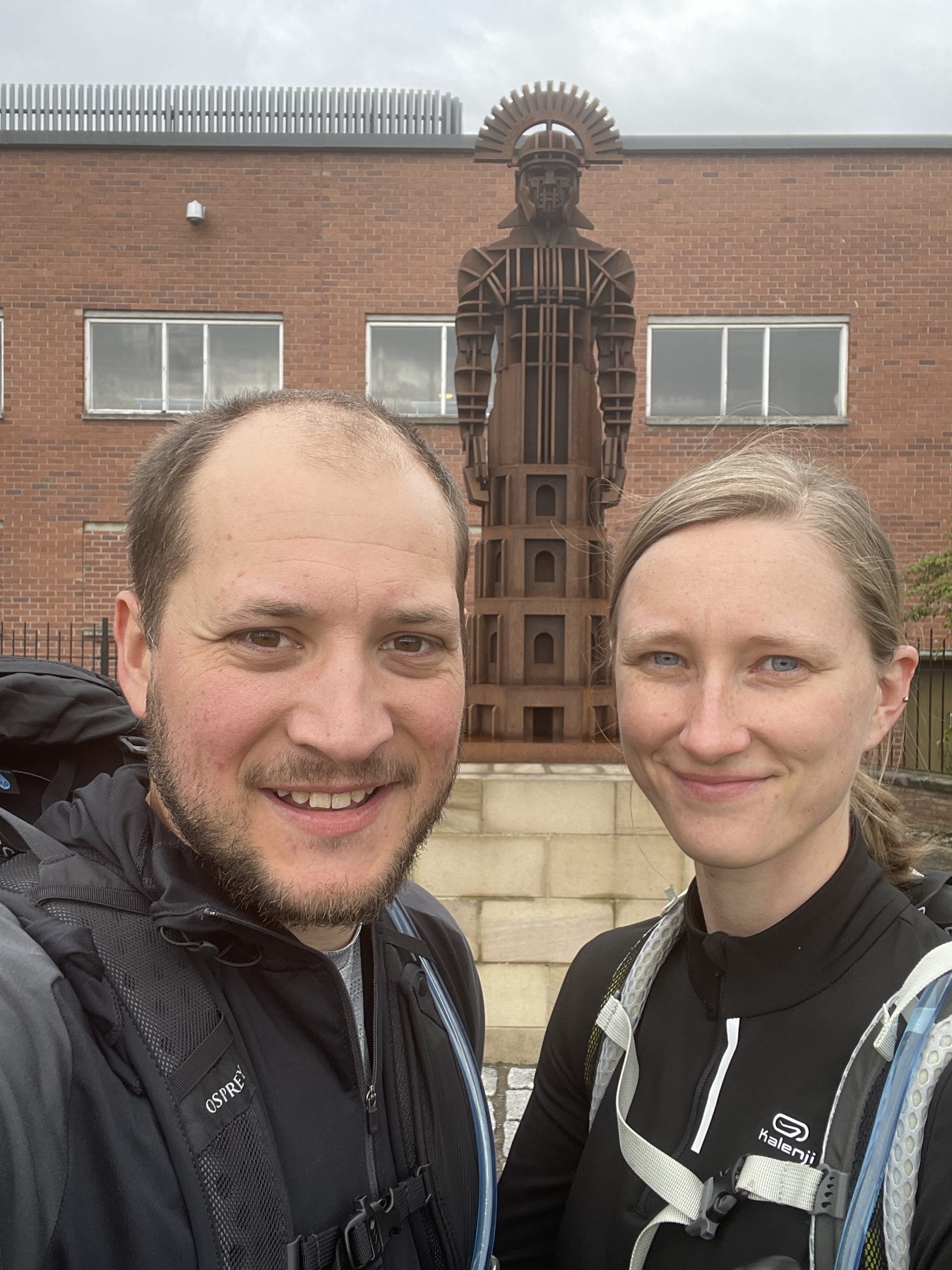

Housesteads Roman fort
Unlike other forts along the Wall, Housesteads is right on the Wall path so doesn’t require a long detour from the route. As the most complete Roman fort in Britain it gives you a real insight into how these forts would have operated all those years ago, and is therefore one of the most popular sites to visit along the Wall path. Just make sure you time your visit right – we arrived at around 3pm which, according to a member of staff, is quite a busy time with coaches dropping off hoards of visitors. We recommend getting there as early as you can to enjoy it before it gets overcrowded.
Alongside the fort, there’s also a small museum on site featuring artefacts discovered from various digs along the Wall, as well as a cafe, shop and toilets at the visitor centre around ten minutes walk just down the hill. While we bypassed the main area of the fort this time around, having visited the site on a dedicated trip in October 2021, we did choose to stop at the visitor centre during our hike and can highly recommend this as a good stopping point for those hiking the Wall. Not only because the lack of public toilets along this section of the route makes the visitor centre a good port of call, but the cafe – while expensive (think National Trust prices!) – offers a variety of meals, drinks and snacks with a lovely picnic area outdoors to take the weight off your aching feet and enjoy a well-earned rest.
Sycamore Gap
(Update 2024: We are devastated that the Sycamore tree was felled in an act of vandalism. While visitors will now only see the stump that remains, Sycamore Gap is still a beautiful stopping point to pause on your hike and admire the view.) If you’ve been doing your research about the Hadrian’s Wall path you’ve most likely heard of Sycamore Gap dozens of times already, and we’re unashamedly adding our recommendation too! Famous for featuring in the 1991 Kevin Costner film ‘Robin Hood Prince of Thieves’, even when you’re expecting to come across this tree it still sneaks up on you, making it all the more awe-inspiring when you do lay eyes on it. Standing tall in a large valley along the Wall, this lone Sycamore tree peeks into view as you descend into the dip and at one point you’re level with the very top of it. We spent a good thirty – forty minutes here in the valley admiring the unusual sight of this tree (and not just because we were attempting to take photographs with no people in the shot!) It’s another fabulous stopping point on the route, where you can quietly sit and admire the view. It’s no wonder that the Sycamore has been described as ‘one of the most photographed trees in the country’ and won the 2016 England’s Tree of the Year award.

Walltown Crags and Walltown Country Park
This spectacular part of the Wall sits between Housesteads fort and Birdoswald fort, and is therefore the most popular section for visitors. This beautiful stretch makes for a fascinating hike while you admire the Roman work on the structure, as well as breath-taking views of the surrounding hills and valleys. This day of our hike took longer than expected, due to the fact that we kept stopping to take photos and take in the scenery! We also found it busier than other sections of the Wall, due to its popularity and the fact that there are many car parks lining this section of the path, making it easy for day-trippers and Wall-hikers alike to visit this part of the Wall.
Due to the undulating and exposed nature of the Wall along this section, we’d recommend stopping off at the picturesque Walltown Country Park, situated in what used to be a quarry. There’s a large lake nestled amongst the trees, with well-paved paths leading to the visitor centre. Here you’ll find light refreshments, a small shop, picnic benches and well-maintained toilets. We enjoyed a longer rest here while we ate our lunch in the sunshine and evaluated the route ahead.
St Oswald’s church
If you’re hiking the path in Spring as we did, you’ll find this church situated in a beautiful meadow of wildflowers. St Oswald’s church was built to commemorate his victory in the Battle of Heavenfield, which took place at this site. A short few minutes deviation off the official Hadrian’s Wall path, the church and its surrounding walls of the churchyard make for a charming scene as you walk towards it. Inside, there is a large Roman altar next to the font, and the church itself provides a place to rest from the hike while you read about the history of the famous Battle that took place here. While it can’t compare to the beauty of the forts or the Wall itself, it’s still a lovely stopping point along the way.
Turrets, altars and inscriptions
If you haven’t already bought a guidebook (and if we haven’t already banged on enough about Henry Stedman’s guidebook in our other blog posts) one of the top reasons to invest in one is to discover evidence of Roman work along the Wall path that we can GUARANTEE you would miss otherwise! Having our guidebook meant we knew where to find incredible Roman artefacts, brickwork and inscriptions along the Wall path – all hidden gems that make the hike truly special. Evidence of Roman life, from graffiti to outlines of milecastles, are all detailed in the guidebook and it’s mind-boggling to think how these elements of Roman life are still standing after almost 2000 years.
One of our favourites is the altar at Great Chesters fort – complete with inscription it is the only one along the Wall that is still in situ at its original standing point. It’s perhaps for this reason that it inspires hikers to leave a small donation on top of the altar for luck.
Another interesting feature along the Wall is the ruined archway at milecastle thirty-seven on Cuddy’s Crags, just West along the path from Housesteads. This archway over a Northern gate was of great significance to the archaeologists who excavated the gateway, as it was from this they were able to determine the height of the archway and therefore the height of the milecastle. You’ll also see small features like holes in the ground where the post for the door to the milecastle stood – it’s incredible to see these small details still in tact.
It’s a good idea to additional time to your daily hike itinerary to allow for stoppage time at turrets and milecastles, some of which well preserved and give a real insight into their layout, while others you could walk by without noticing the unexcavated outline where they stood.

Other recommendations off the Wall path:
We were sad to make adjustments halfway through our hike, only due to the fact that we tried to cram too much into our trip! If you have the time, or are hiking the route in sections as opposed to all at once, we’d recommend visiting:
Vindolanda fort and museum
We were looking forward to visiting Vindolanda on day four of our hike, though ultimately the evening before we decided we just couldn’t squeeze it into our trip. With over 30km to cover that day, plus however many hours Vindolanda would occupy us for, and the fact that there are no lockers at the museum for hikers to store cumbersome backpacks meant that we decided to forgo the hour round trip off the route and instead stayed our course. Our feet thanked us that evening, though we still have plans to visit at a later date. If you’re not planning to hike the entire Wall path, instead opting for a day trip, we’ve heard that Vindolanda is one of the most important sites for discoveries of Roman artefacts. With excavations taking place on site every week between March and September there’s always a chance your visit will coincide with an archeological discovery!
Chesters fort
With a shorter day of just 15km planned, we had every intention of visiting Chesters. However, by the time we’d checked into our hotel for the evening to jettison backpacks before heading out, we realised Chesters would close in an hour’s time! We figured just wasn’t enough to appreciate the fort in all its glory, and instead visited the Roman bridge abutment ruins on the other side of the river.
If you’re like us and would be happy enough to see the fort from a distance, you can get a pretty decent view of part of Chesters from the other side of the river. This gives you a good lookout over what used to be the bathhouses, which are still very well preserved. For those who like to dive into the history, it would be well worth allocating a few hours to explore the fort and museum, and spend some time sitting by the river admiring the well-preserved stonework.
Corbridge Roman town
Like Vindolanda, we would have loved to visit Corbridge on our hike but it was just too far off the Wall path for us as we didn’t have the time to spare. We’ve heard Corbridge described as a perfect time capsule of Roman life, where you can walk the streets and visit the museum with its various artefacts providing a real insight into Roman life. Not to be missed if you can spare the time to deviate from the Wall path.
If you found this post helpful, please support our blog by donating as little as £1 to our running costs! Thank-you!

We are Chris+Suze
Related Posts

Hadrian's Wall Path guidebook
This guidebook was our most valuable investment when we hiked the Hadrian’s Wall Path. It outlines the entire route no matter which end you start from, and has handy maps and illustrations as well as details of campsites and BnBs. Highly recommend buying this book to accompany you if you’re hiking the HWP!

Klean Kanteen
We’ve owned Klean Kanteens for years – even before we started house sitting! Our bottles are still not showing any signs of wear and tear. They’re durable and lightweight, and can easily be clipped onto a bag when dog walking or hiking.

Thank you for reading!
We hope you’ve enjoyed this post! For more posts about hiking and great places to visit, head to our blog or follow us on Instagram and Facebook for photos and videos from our travels! Let us know in the comments – have you hiked the Hadrian’s Wall Path? Or has our post inspired you to go!
